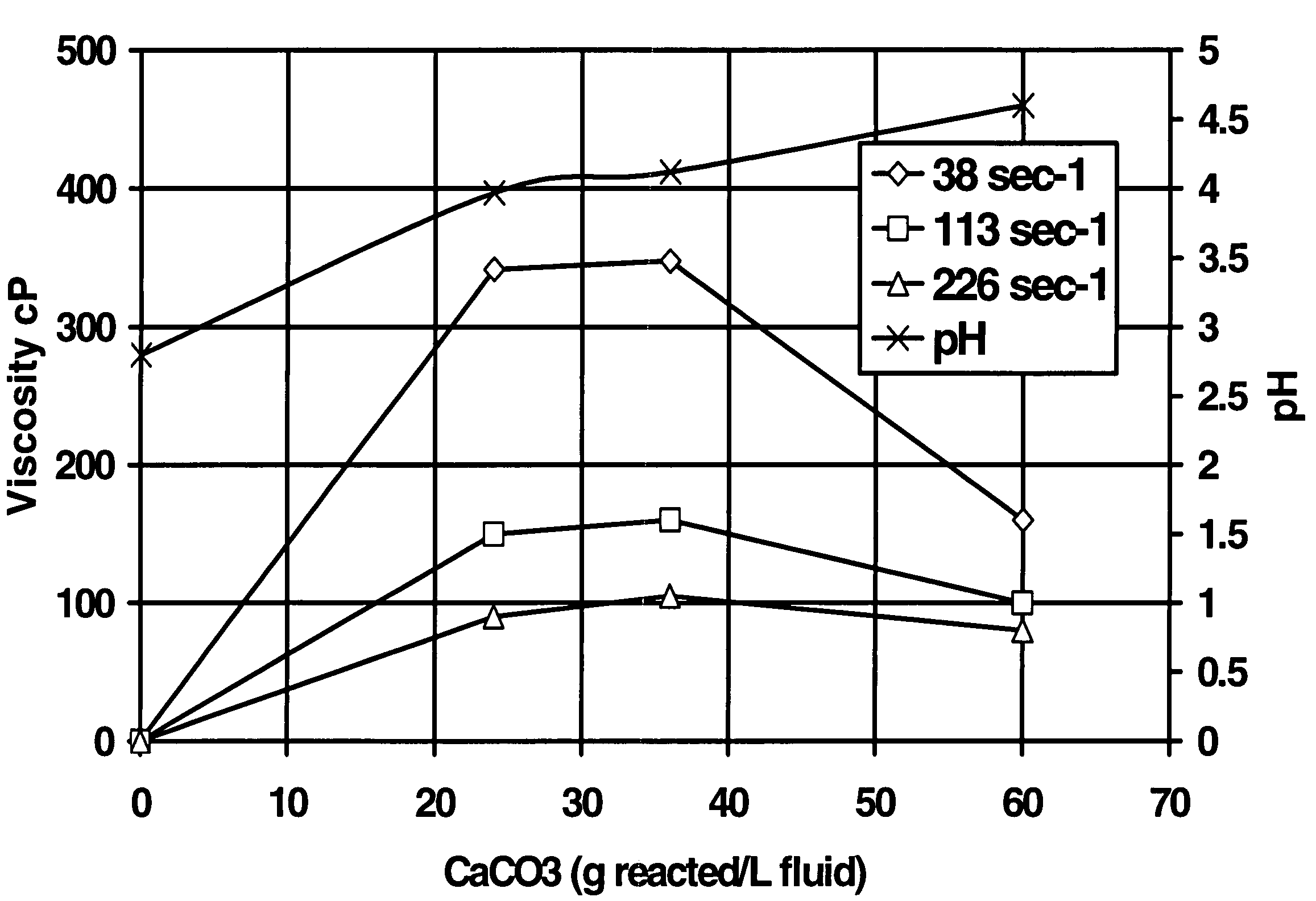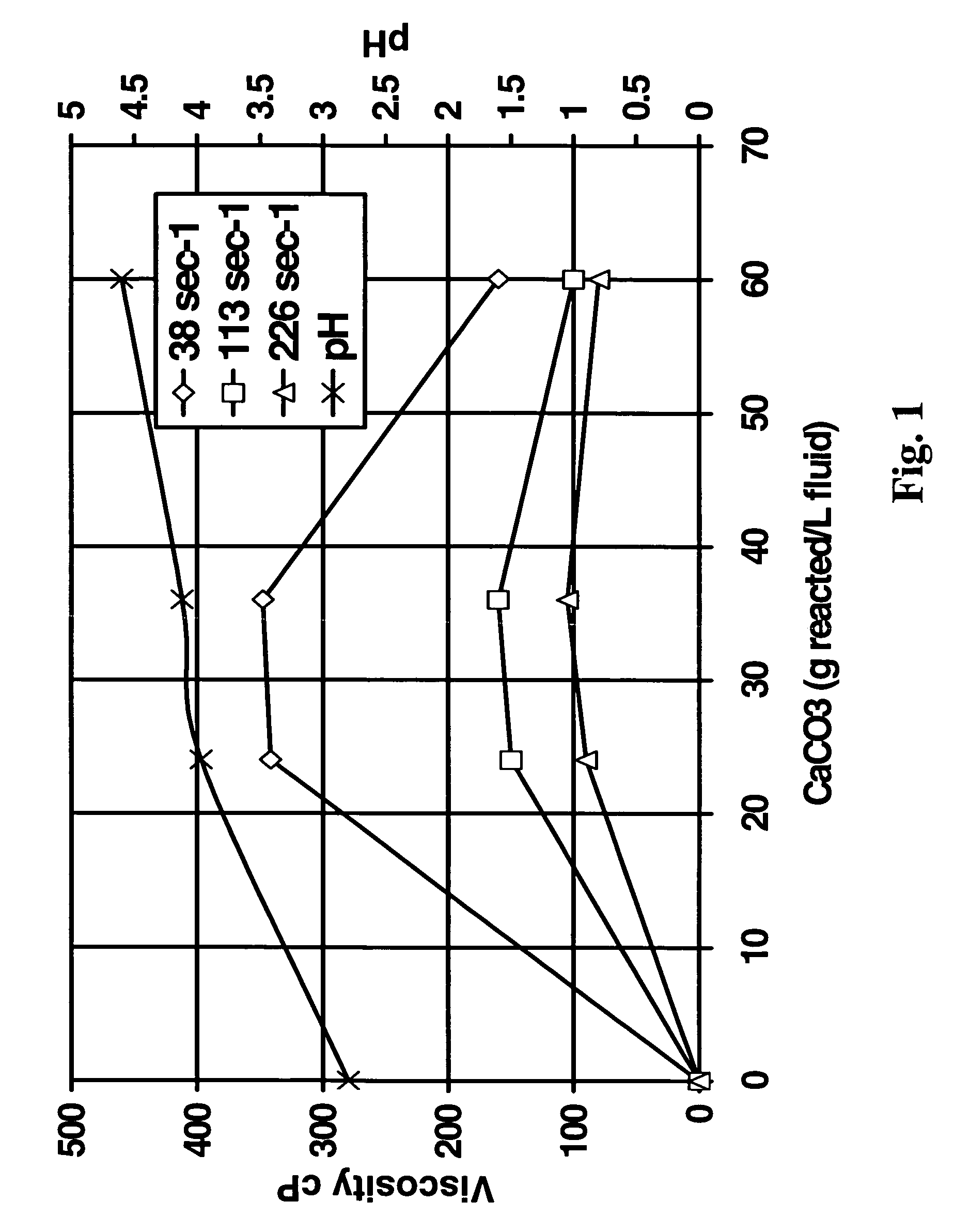Composition and method for treating a subterranean formation
a subterranean formation and composition technology, applied in the direction of fluid removal, chemistry apparatus and processes, borehole/well accessories, etc., can solve the problems of high reactive acidity, failure to produce, and inability to form wormholes, etc., to achieve easy leakage control, reduce drag, and reduce friction pressure
- Summary
- Abstract
- Description
- Claims
- Application Information
AI Technical Summary
Benefits of technology
Problems solved by technology
Method used
Image
Examples
example 1
[0044]An initial bench-top, small-scale experiment was performed by preparing a live acid formulation with 20% HEDTA dissolved in water and reduced in pH from about 12 to about 2.8 with HCl. 1% methanol, 0.2 to 0.4% corrosion inhibitor, and 7.5% BET-0-40 were added and agitated in a jar. A light gel was formed with a viscosity of about 100 cP, at 170 sec-1 at room temperature (estimated, as the sample was not large enough to measure). The formulation was spent using two spatula-fulls of powdered calcium hydroxide with mild agitation performed by shaking the jar. After about one minute, no visible signs of additional thickening were observed. However, after 2-3 minutes, a thick fluid that hung on the lip of the jar when the jar was tilted as if to pour out any liquid therein, reminiscent of heavily crosslinked fracturing gels, was produced.
example 2
[0045]The second test was a test to determine the feasibility of using the method of the present invention in reservoirs (simulated with crude oil) having a high tendency to generate sludge and / or precipitate asphaltenes in the presence of highly concentrated HCl or organic acid blend. A fluid was prepared starting with aqueous 20% HEDTA reduced to a pH of about 2.8 with hydrochloric acid, 1% methanol, 2.6% corrosion inhibitor, 0.3% non-emulsifier, and 7.5% BET-O-40 in the presence of 1000 ppm Fe+++. As shown in FIG. 1, the system gelled in the presence of CaCO3; the change in viscosity was more pronounced at low sheer. The x-axis in FIG. 1 is the grams of CaCO3 reacted per L of this fluid.
example 3
[0046]A test was conducted to ascertain the corrosive effect of the fluid system utilized in practicing the method of the present invention as follows. Fluids were prepared with reagent grade chemicals diluted with tap water. One inch by 1.5 inch (2.5 cm×3.8 cm) test coupons of L80 and P110 steels were numbered for identification, cleaned, rinsed in acetone, dried and weighed, and then stored in a desiccator until use. Corrosivity was evaluated in an autoclave at 270° F. (132° C.) with exposure time to six hours at 3000 psi (20.7 MPa). Following the test, the coupons were rinsed in acetone and scrubbed with soap and water to remove inhibitor film and corrosion deposits. A final rinse in acetone was completed prior to re-weighing the metal coupons to calculate corrosion rates. The corrosion rates observed are shown below with a pitting index score by which (a pitting index of 3 or less is considered acceptable) determined by the size and depth of pits as shown in the following table:...
PUM
 Login to View More
Login to View More Abstract
Description
Claims
Application Information
 Login to View More
Login to View More - R&D
- Intellectual Property
- Life Sciences
- Materials
- Tech Scout
- Unparalleled Data Quality
- Higher Quality Content
- 60% Fewer Hallucinations
Browse by: Latest US Patents, China's latest patents, Technical Efficacy Thesaurus, Application Domain, Technology Topic, Popular Technical Reports.
© 2025 PatSnap. All rights reserved.Legal|Privacy policy|Modern Slavery Act Transparency Statement|Sitemap|About US| Contact US: help@patsnap.com


